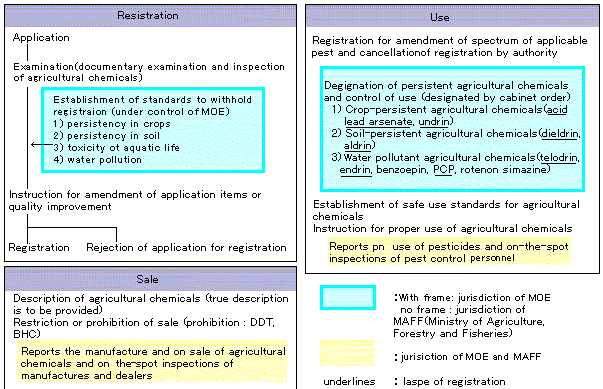Water / Soil / Ground Environment
Countermeasures against Pollution by Agricultural Chemicals
Present State of Pollution by Agricultural Chemicals
Along with the increased use of agricultural chemicals after World War II, the pollution of food and the environment by agricultural chemicals such as BHC, DDT, dieldrin, and organic mercury agents became a serious social issue. Today, such highly toxic or persistent agricultural chemicals are no longer used nor registered for sale in Japan owing to both the tightening of regulations to control their use under the Agricultural Chemicals Regulation Law revised in 1971 (hereinafter referred to 'the law') and the development of less toxic substitutes thanks to advances in science and technology. Therefore, the environmental pollution caused by persistent agricultural chemicals has decreased. Since 1988, water pollution resulting from the use of agricultural chemicals on golf courses became a serious social issue. However, the situation has improved considerably due to the establishment of the Guidelines mentioned below. Nevertheless, as agricultural chemicals are potentially bioactive and may affect living organisms and the environment, it is necessary to properly assess their safety and to control their use in order that they do not adversely impact human health or the environment.
Countermeasures against Pollution by Agricultural Chemicals
In order to prevent pollution by agricultural chemicals in Japan, the law requires that any agricultural chemical proposed for use must be registered for sale, a process that includes evaluation of the persistency, toxicity, and other characteristics. All agricultural chemicals registered for sale must satisfy criteria in each of the following categories regarding: (1) persistency in agricultural products; (2) persistency in soil; (3) toxicity to aquatic animals and plants; and (4) water pollution. As of February 1998, the standards for persistency in agricultural products had been established for 318 agricultural chemicals and the standards for water pollution had been established for 88 chemicals (the establishment of standards for water pollution started in April 1993). A common standard for persistency in soil and toxicity against aquatic animals and plants has been established for all agricultural chemicals.
Even after registration, any agricultural chemical may still be designated by a cabinet order, as provided for by the law, as an agricultural chemical that causes crop persistency, soil persistency, or water pollution. If any chemical is found to have the danger of causing damage to the health of humans or livestock through crops, soil, or water, its use will be strictly regulated.
In 1990, the Environment Agency has also established the Guidelines for Prevention of Water Pollution by Agricultural Chemicals used on golf courses to promote countermeasures.
Structure of Agricultural Chemicals Regulation Law
